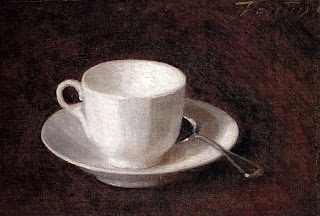 |
| White Cup and Saucer (1864), Henri Fantin-Latour |
Everything is so instant nowadays. Instant photos, instant messages, instant coffee (not!). Remember when you did long division, or used a slide rule, before everything was made easier with a calculator? Or snapping a picture with a camera and waiting to develop the photos? How about whipping out a sketch pad and making your own impression of your surroundings? Today, we rely on a cellphone to readily capture what we see by clicking a button, never thinking of picking up a pencil and paper.
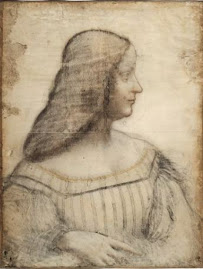 |
Portrait of Isabella d'Este
(1499-1500), Leonardo da Vinci |
Sketching and drawing are lost arts. Yet, they are perfect examples of ways to settle your mind, reduce stress, and spend time observing the world around you. Artists use sketching to plan out their final paintings and to establish the value range of light to dark. They often focus on particular details, using them as components for later compositions. This approach helps cement the images in your mind for later retrieval. Da Vinci sketched this woman, using her costume and hand gestures later in his portrait of the Mona Lisa. Even musicians practice in jam sessions before cutting the final track.

You also need to sit down and focus your attention on a particular subject or scene, like these kangaroos from a zoo or wildlife setting. Begin with rough sketches and numerous studies. Take notes and some reference photographs or simply rely upon your own memories. Sometimes, just capturing various shapes of trees, shadows, and using shading to capture the direction of your light source is all you need. The arrangement of shapes composes an image. Having a black-and-white drawing allows you to experiment with the colors later, relying on your emotions and memories to depict a mood.
 |
| Van Gogh Sketches |
In high school, a classmate and I would bring our sketchpads to sporting events and draw basketball players in action. My brother would sketch portraits of local professional baseball players. I remember going to a car dealership where some of the NY Yankees were doing a promotion, and my brother got Whitey Ford to sign his portrait. Vincent Van Gogh often included sketches in his letters to his brother, Theo.
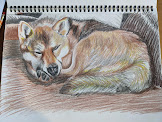 |
| Drawing of Jeju |
 |
| Photo of Jeju |
Photographs capture lighting and atmospheric conditions that may undergo change while trying to paint a scene outdoors (en plein air). Sketching, on the other hand, is interactive and very fluid, allowing you to experience the subject and etch it into your memory.
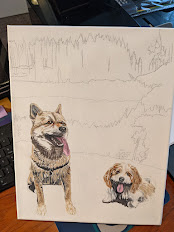 |
| My Sketch / Painting |
 |
| Photograph at Lake Sawyer |
While sketching requires looking at a subject, it can also be completely made up from your mind. It helps to obtain an understanding of anatomy and proportion when sketching animals or human figures. Learning to rely upon quick lines and the ability to edit out unnecessary details simply takes practice. Start by working on the body of a subject, then fill in the background later. A finished drawing or painting will take much more time and practice to complete.
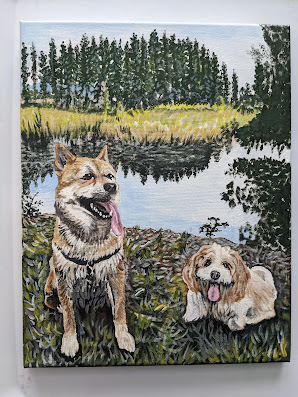 |
| Final Painting of Dogs at Lake Sawyer |
The paper you choose for drawing will usually be of higher quality than what you use for sketching. You can find sketch pads in a variety of sizes, textures, and finishes. Drawing paper is typically thicker and denser with rougher texture for grabbing graphite pencil, ink, charcoal, pastel, or other artistic medium. On watercolor paper, I suggest using a light colored pencil, while on a gessoed canvas surface I would use graphite pencil or charcoal. Such sketching is used more as a guide to laying out a painting, although my subjects (above) needed to be much more detailed.









No comments:
Post a Comment
Do you have a favorite art movement or style? What's your favorite abstract artwork?